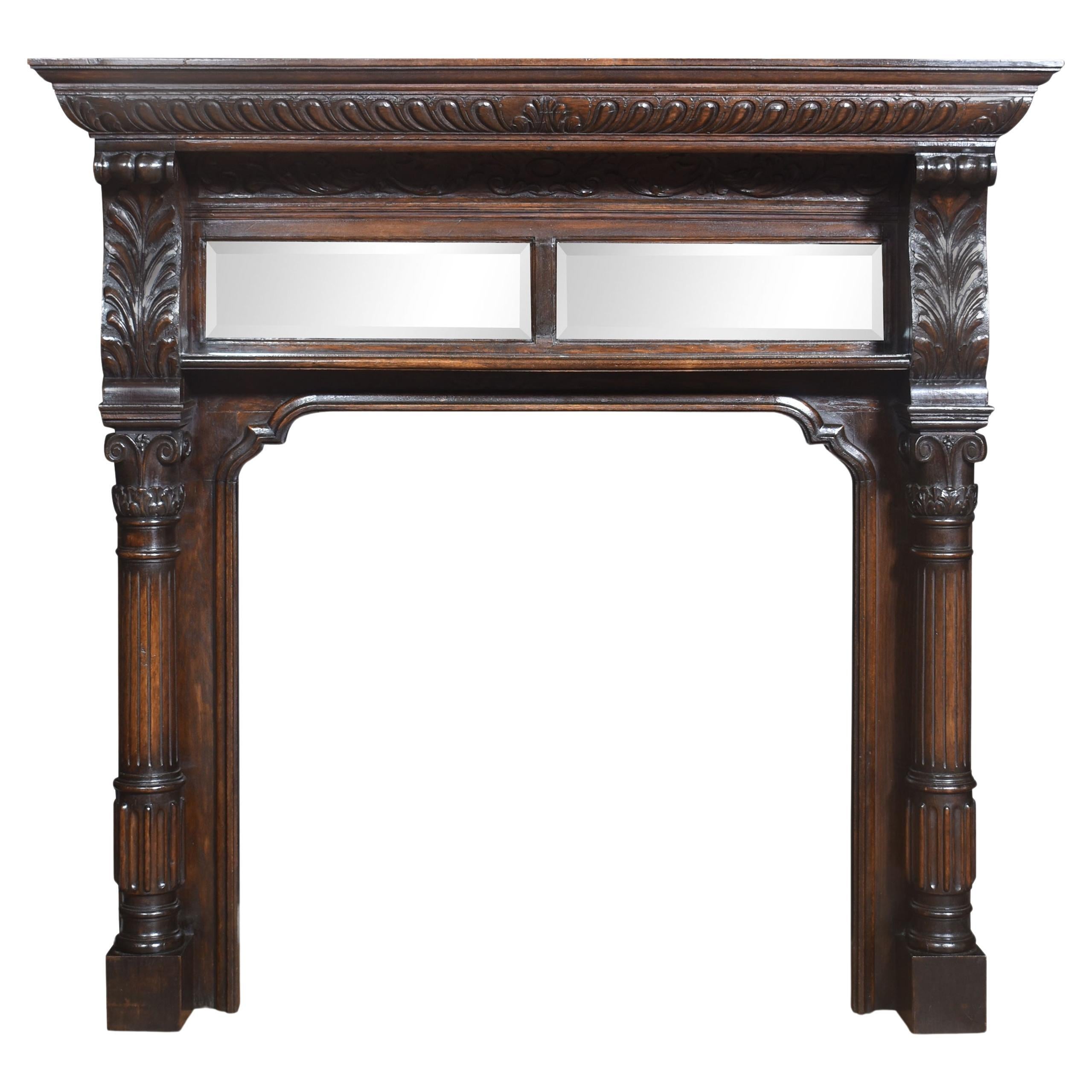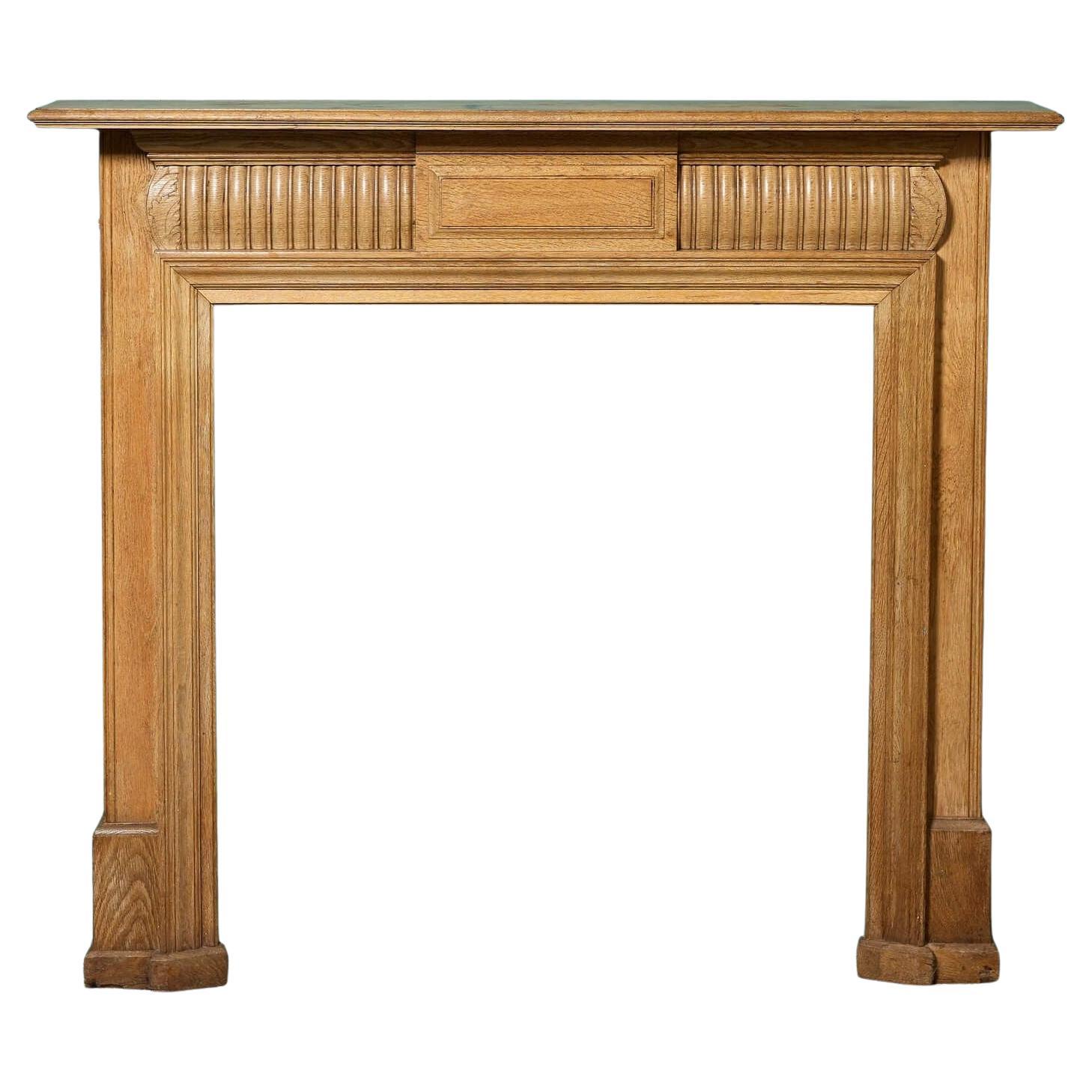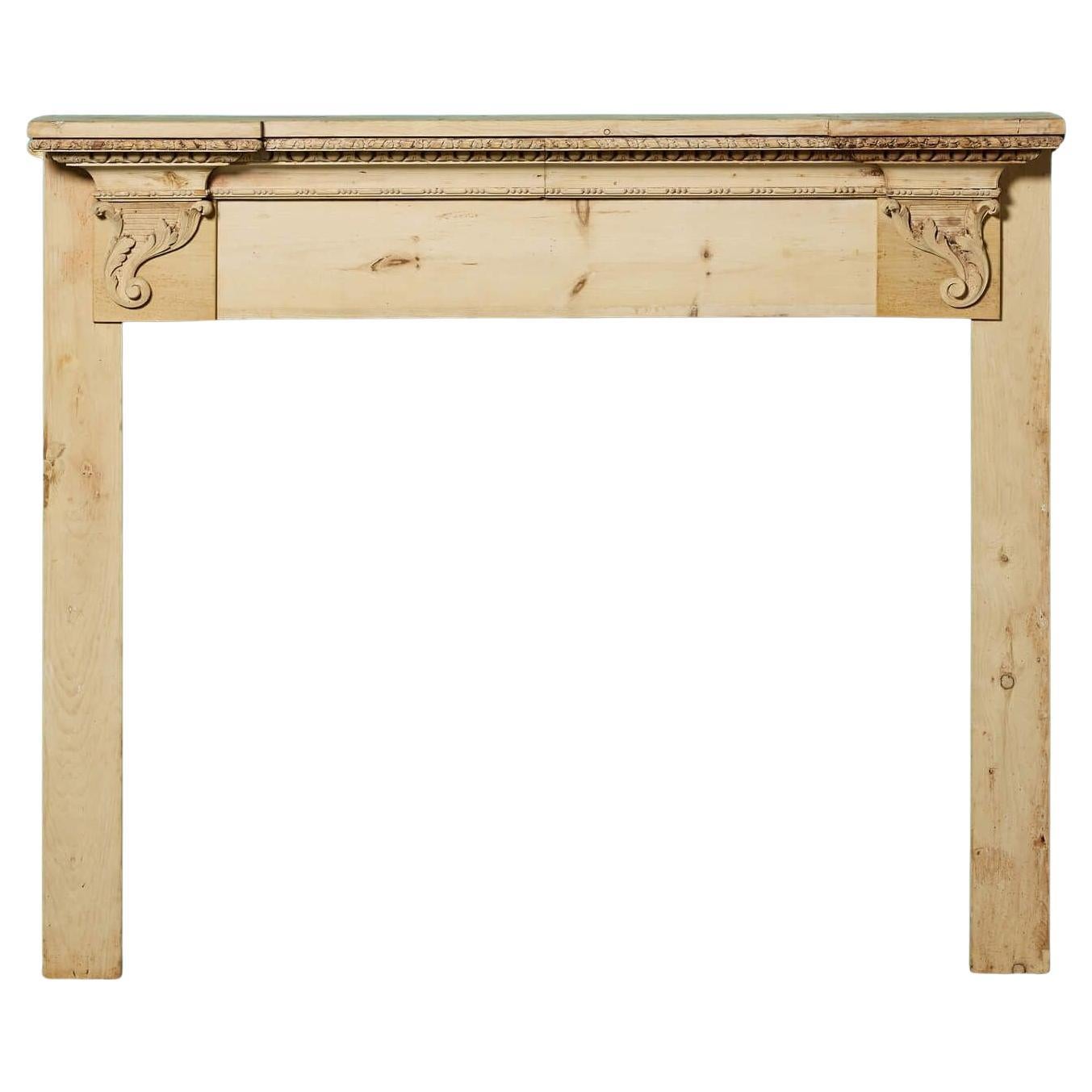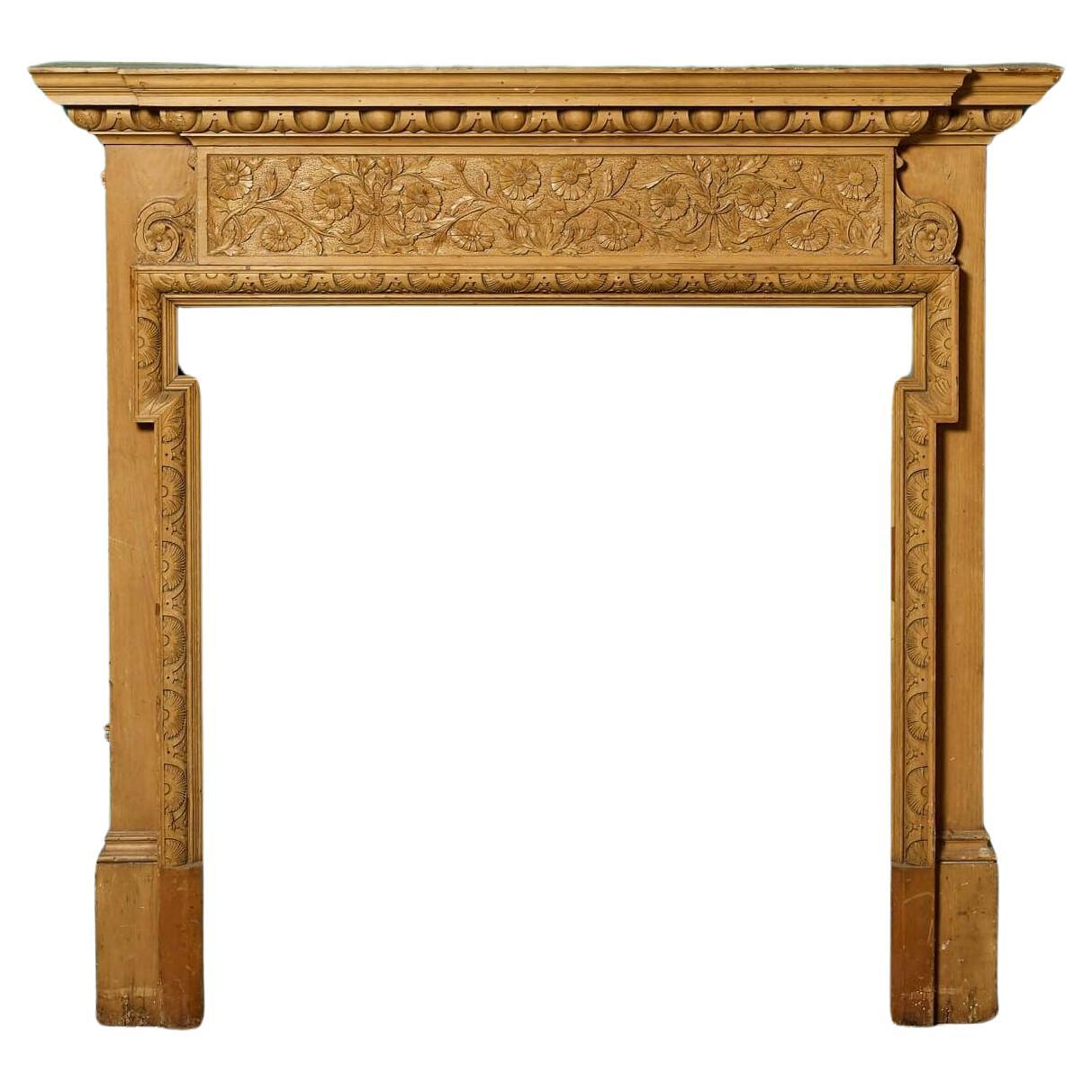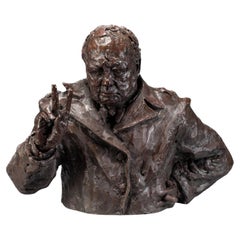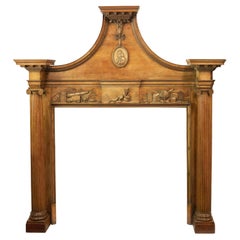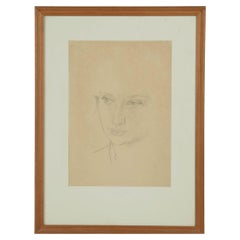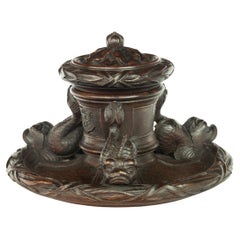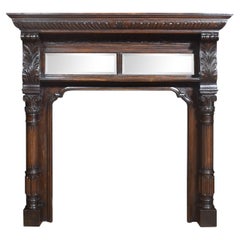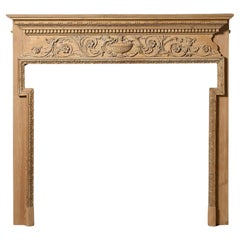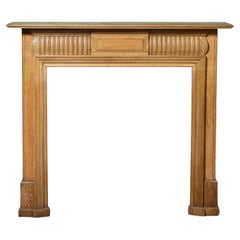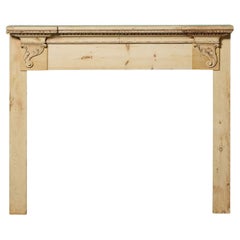Items Similar to A carved fire surround from Sir Winston Churchill’s drawing room
Want more images or videos?
Request additional images or videos from the seller
1 of 6
A carved fire surround from Sir Winston Churchill’s drawing room
About the Item
A carved fire surround from Sir Winston Churchill’s drawing room. This carved pine fire surround combines elements of both Rococo and Palladian designs. It has a shaped cornice above a frieze of foliate arabesques and floral garlands centred on a raised panel of confronting C-scrolls, leaves and flowerheads. The supports have recesses at the corners and the whole inner edge is decorated with a gadrooned border. English, circa 1910.
Provenance: 28 Hyde Park Gate, London, home of Sir Winston and Baroness Churchill from 1945 until Sir Winston’s death in 1965
Literature: Knight, Frank and Rutley The London Home of the late Sir Winston Churchill, K.G., O.M., C.M., and of Baroness Spencer-Churchill G.B.E., 28 Hyde Park Gate together with 27 Hyde Park Gate auctioned 28th October 1965 (the fire surround pictured in situ in the drawing room of number 28)
Country Life, 2nd September 1965 illustrated in an advert for the above sale.
Illustrated London News, 5th December 1959 cover featured the Churchills in the drawing room at No. 28 to celebrate Sir Winston’s 85th birthday.
28 Hyde Park Gate was built in 1842 and described, by the Bayswater Chronicle in 1945, as ‘a pleasant red-brick house, which has three reception rooms and nine or ten bedrooms’ on which ‘a lot of money has been spent’. However, after losing the general election of 1945, Churchill bought 28 Hyde Park Gate as a London base (his other home being Chartwell, in Kent and immediately had it redecorated. One room was assigned as what he called his ‘snob library’ of beautifully bound books. The walls were hung with pictures of his aristocratic ancestors, who included the Ist Duke of Marlborough, victor of the Battle of Blenheim. The following year he also purchased number 27, next door, for £7,000, originally for use as office accommodation. He later had the two houses combined and they formed his longest standing London residence. (English Heritage.)
- Dimensions:Height: 53.5 in (135.89 cm)Width: 67 in (170.18 cm)Depth: 6.75 in (17.15 cm)
- Materials and Techniques:
- Place of Origin:
- Period:1910-1919
- Date of Manufacture:Circa 1910
- Condition:Wear consistent with age and use.
- Seller Location:Lymington, GB
- Reference Number:1stDibs: LU973036767002
About the Seller
5.0
Recognized Seller
These prestigious sellers are industry leaders and represent the highest echelon for item quality and design.
Established in 1982
1stDibs seller since 2013
127 sales on 1stDibs
Typical response time: 8 hours
Associations
LAPADA - The Association of Arts & Antiques Dealers
- ShippingRetrieving quote...Shipping from: Lymington, United Kingdom
- Return Policy
Authenticity Guarantee
In the unlikely event there’s an issue with an item’s authenticity, contact us within 1 year for a full refund. DetailsMoney-Back Guarantee
If your item is not as described, is damaged in transit, or does not arrive, contact us within 7 days for a full refund. Details24-Hour Cancellation
You have a 24-hour grace period in which to reconsider your purchase, with no questions asked.Vetted Professional Sellers
Our world-class sellers must adhere to strict standards for service and quality, maintaining the integrity of our listings.Price-Match Guarantee
If you find that a seller listed the same item for a lower price elsewhere, we’ll match it.Trusted Global Delivery
Our best-in-class carrier network provides specialized shipping options worldwide, including custom delivery.More From This Seller
View AllA bronze portrait of Sir Winston Churchill by Rufus Martin, 2023
Located in Lymington, Hampshire
A bronze portrait of Sir Winston Churchill by Rufus Martin, 2023 This head and shoulders bronze bust is instantly recognizable as Sir Winston Churchill. He is wearing a British Warm greatcoat with epaulettes and has a half-smoked cigar in the left hand resting on his hip. His right hand is raised in his trade mark V-for-Victory salute. Signed ‘Rufus Martin 1/12’.
Sir Winston Churchill (1874 –1965) was a British politician, army officer and writer. He was the Prime Minister of the United Kingdom from 1940 to 1945, when he led Britain to victory in the Second World War, and again from 1951 to 1955. Churchill represented five constituencies during his career as a Member of Parliament. Ideologically an economic liberal and imperialist, for most of his career he was a member of the Conservative Party, which he led from 1940 to 1955, but from 1904 to 1924 was a member of the Liberal Party. This portrait of Churchill by Rufus Martin is striking for its juxtaposition of this famous historical subject and the free and contemporary choice of presentation. Churchill’s tenure during the Second World War infused the nation with calm and confidence, providing the British people with strong leadership during its darkest hours. Martin succeeds in portraying Churchill’s unshakeable belief in a successful outcome for the Allies through his defiant stance, unwavering gaze and Victory V gesture. Together with the recognizable “Bulldog” facial features and broad shoulders, this bust captures the subject in terms of character as well as being an accurate physical portrait .
Rufus Martin trained at Wimbledon College of the Arts, London, though his aptitude for 3D design and sculpture was apparent from a very young age. His mother, a portrait painter, showed him the portrait sculptures of Augusta Savage, Jacob Epstein and Augustine Rodin, which inspired him to create a bust of his late mentor, Michael Howells. He sculpts ‘intriguing individuals, always hoping to capture some element of their past or current struggles and to create something for the good of the community they inhabit and wherever possible for posterity’ – an ambition he has most successfully fulfilled with this powerful portrait.
After leaving college in 2017, with first class honours, Martin has won many prestigious prizes including the Tiranti Prize at the FACE, the Signature Art Award, the Chelsea Arts Club show for ‘Amy’, the True Blue Show, the Salmagundi Open Show, New York, Green & Stone Summer Show, the Chelsea Arts Society Summer Show, RBA Rising Stars, the Royal Cambrian Academy Open, the
Binny Mathews & Sons joint show, The Next Big Thing and has been published in the Kings House...
Category
2010s English Busts
Materials
Bronze
A George III carved pine chimneypiece from The Marine Society by Tousey, 1775
Located in Lymington, Hampshire
This pine chimneypiece has a swan-neck pediment supporting three pedestals, with dentil and leaf borders. There is a central limewood oval portrait of Robert Marsham, 2nd Baron Romney carved in relief and suspended by acanthus and tied ribbons. The frieze below is also applied with limewood carving of naval trophies, emblematic of seamanship and learning, flanking a central tablet depicting a reclining Marine Society boy. The supports are composed of large fluted columns with Ionic capitals and edged with egg and dart borders and leaf-carved mouldings. English, 1775.
Provenance: Supplied by Mr. Tousey for the Committee Room of the Marine Society at
No. 54 Bishopsgate Street, London, in April 1775 at a cost of £30.15s 6d
removed to Clark’s Place, Bishopsgate Street, London, in 1891
Published: Woodman, Richard “…..of daring temper 250 years of the Marine Society.” London 2006, pp 24-25.
Bosanquet, Henry T. A., The Marine Society, A Catalogue of the Pictures and other Works of Art, 1905, p. 14.
The Marine Society is the world’s oldest public maritime charity and was the brainchild of Jonas Hanway. In 1756, at the beginning of the Seven Years’ War, he reflected on Britain’s woefully undermanned and ill-equipped navy. His idea was to ensure that young men and boys who wished to ‘learn the duty of seaman…shall be handsomely clothed and provided with bedding, and their charges born down to the ports where His Majesty’s Ships lye with all other proper encouragement.’ During the ensuing hostilities the Society equipped 5,140 men and 4,787 boys for the Navy. In 1793 Admiral Lord Nelson, a governor of the Society, requested 20 lads to join his 64-gun ship Agamemnon at Chatham. By the Battle of Trafalgar in 1805, at least 15% of British naval manpower was being supplied, trained and equipped by the Marine Society. By 1774, the Society had outgrown its offices in the Royal Exchange and moved to 54 Bishopsgate Street. Detailed minutes of the weekly Committee meetings describe the furnishing of the Society’s new Committee Room, including ‘a carved chimneypiece...
Category
Antique 1770s English Fireplaces and Mantels
Materials
Pine
An original portrait drawing by Sir Stanley Spencer of Daphne Spencer, his niece
Located in Lymington, Hampshire
An original portrait drawing by Sir Stanley Spencer of Daphne Spencer, his niece (and reputedly his lover), finely drawn with the sitter looking slightly to the right, pencil on car...
Category
20th Century English Drawings
Materials
Paper
An oak inkwell carved from Lutine timber, dated 1799
Located in Lymington, Hampshire
This large and historically interesting inkwell, or standish, is carved from timber recovered from the wreck of H.M.S. Lutine. It has a central inkwell, with a bud and oakleaf cover...
Category
Antique 1860s Nautical Objects
Materials
Oak
Sir Harold Dudley Clayton’s scale model of Coquette, 1899
Located in Lymington, Hampshire
Sir Harold Dudley Clayton’s scale model of Coquette, 1899. This large model is of the 1/12th scale 10-ton Bristol Channel One Design class Coquette: She is fully rigged with furled s...
Category
Antique 19th Century English Nautical Objects
Materials
Wood
Sir Harold Dudley Clayton’s Hydraulic Steam Lifeboat: City of Glasgow, 1894
Located in Lymington, Hampshire
Sir Harold Dudley Clayton’s Hydraulic Steam Lifeboat: City of Glasgow, 1894. This fine builder’s presentation scale model has a gilt brass funnel, polished brass rudder, capstan, anchor, binnacle and fittings with side grab ropes. The hull is painted in RNLI blue and red, with a pink keel. It is raised on a turned brass support within an ebonised glazed case on a stand and has a presentation plaque inscribed ‘Hydraulic Steam Lifeboat City of Glasgow’ Built For the Royal National Lifeboat Institution, by R & H Green, Blackwall Yard, London, 1894′.
Provenance: Sir Harold Dudley Clayton. The following pages are dedicated to the substantial and fascinating archive of Sir Harold Dudley Clayton. This includes the lifeboat model above, over 100 yacht designs and naval architects’ drawings, photograph albums, photographic glass slides and a model of his yacht Coquette.
Steam-powered lifeboats. Earlier in the 19th century steam had transformed Britain’s industrial landscape through the development of steamships and the railways. But tending a coal-fired boiler in a boat that is pitching and rolling in heavy seas would not have been straightforward. Sixty years after the idea was first mooted by Sir William Hillary and after extensive trials, the first steam-cum-sail boat Duke of Northumberland went into service at Harwich Lifeboat Station in September 1890. The hydraulic steam-driven lifeboat used...
Category
Antique 19th Century English Nautical Objects
Materials
Brass
You May Also Like
Carved oak fire surround
Located in Cheshire, GB
Carved oak fire surround, the rectangular mantle above carved detail. to the acanthus capitals flanking two original bevelled mirrors. Supposed on bo...
Category
Early 20th Century British Fireplaces and Mantels
Materials
Oak
$3,924
Georgian Style Carved Pine Fire Surround
Located in Wormelow, Herefordshire
A late Georgian style carved pine fire surround, circa 1850. Crafted at the hand of a talented 19th century woodworker, this antique fireplace is beautifully carved, the frieze depic...
Category
Antique 19th Century English Georgian Fireplaces and Mantels
Materials
Pine, Wood
Antique Victorian Carved Oak Fire Surround
Located in Wormelow, Herefordshire
A handsomely carved antique Victorian oak fire surround dating to circa 1900.
The light wax finish of the mid tone oak compliments the raised panelled frieze panel complimented by a...
Category
Early 20th Century English Edwardian Fireplaces and Mantels
Materials
Wood, Oak
Reclaimed Antique Carved Pine Fire Surround
Located in Wormelow, Herefordshire
A good quality antique carved pine fire surround, reclaimed from a property in Surrey, UK. This simple fireplace is an elegant addition to any interior with its stripped pine finish ...
Category
Antique Late 19th Century English Georgian Fireplaces and Mantels
Materials
Pine, Wood
Arts & Crafts Style Carved Oak Fire Surround
Located in Wormelow, Herefordshire
An arts and crafts style oak fireplace dating to circa 1900.
This surround has a handsome dark tone to the expertly carved solid oak, showcasing a beautiful Tudor rose to the centre...
Category
Early 20th Century English Arts and Crafts Fireplaces and Mantels
Materials
Metal, Iron, Wrought Iron
Victorian Arts & Crafts Carved Pine Fire Surround
Located in Wormelow, Herefordshire
A Victorian Arts and Crafts pine fire surround carved with stylised flowers and foliage to the frieze. This beautiful fireplace is relatively petite in size, making it suitable for a...
Category
Antique Late 19th Century English Arts and Crafts Fireplaces and Mantels
Materials
Pine, Wood
Recently Viewed
View AllMore Ways To Browse
Antique Drawing Room Furniture
Fire Door
Antique Bedroom Fireplace
At The Edge Of The Pines
Antique Fire Door
Frieze Drawing
Fire Door Used
Rococo Wall Panel
English Palladian Furniture
English Palladian
Auction House Books
Marlborough Duke
Grecian Fireplace Mantel
Hercules And Omphale
Moyr Smith
Nero Marquina Mantel
Scottish Baronial
Victorian Marble Fireplace And Cast Iron Insert
